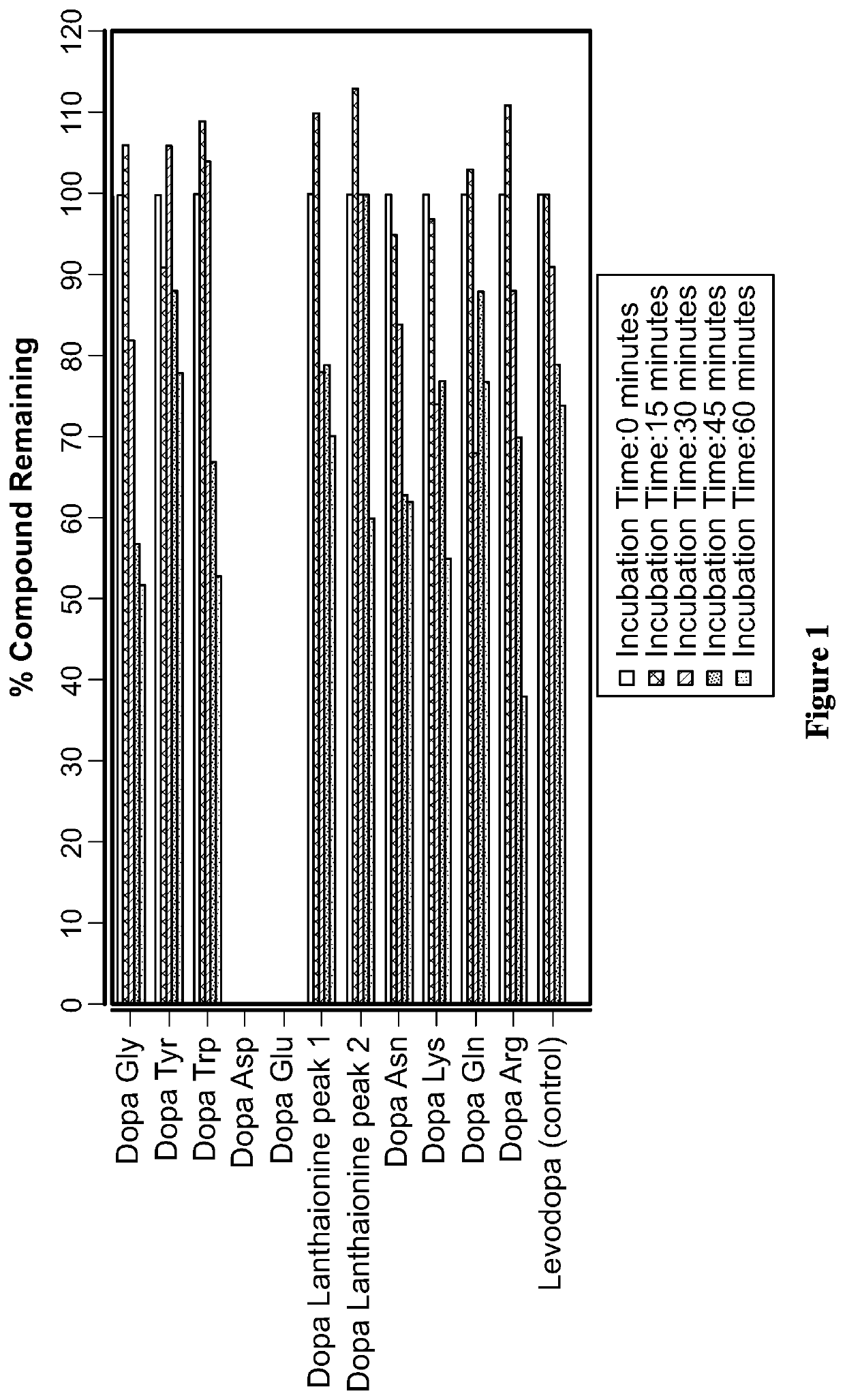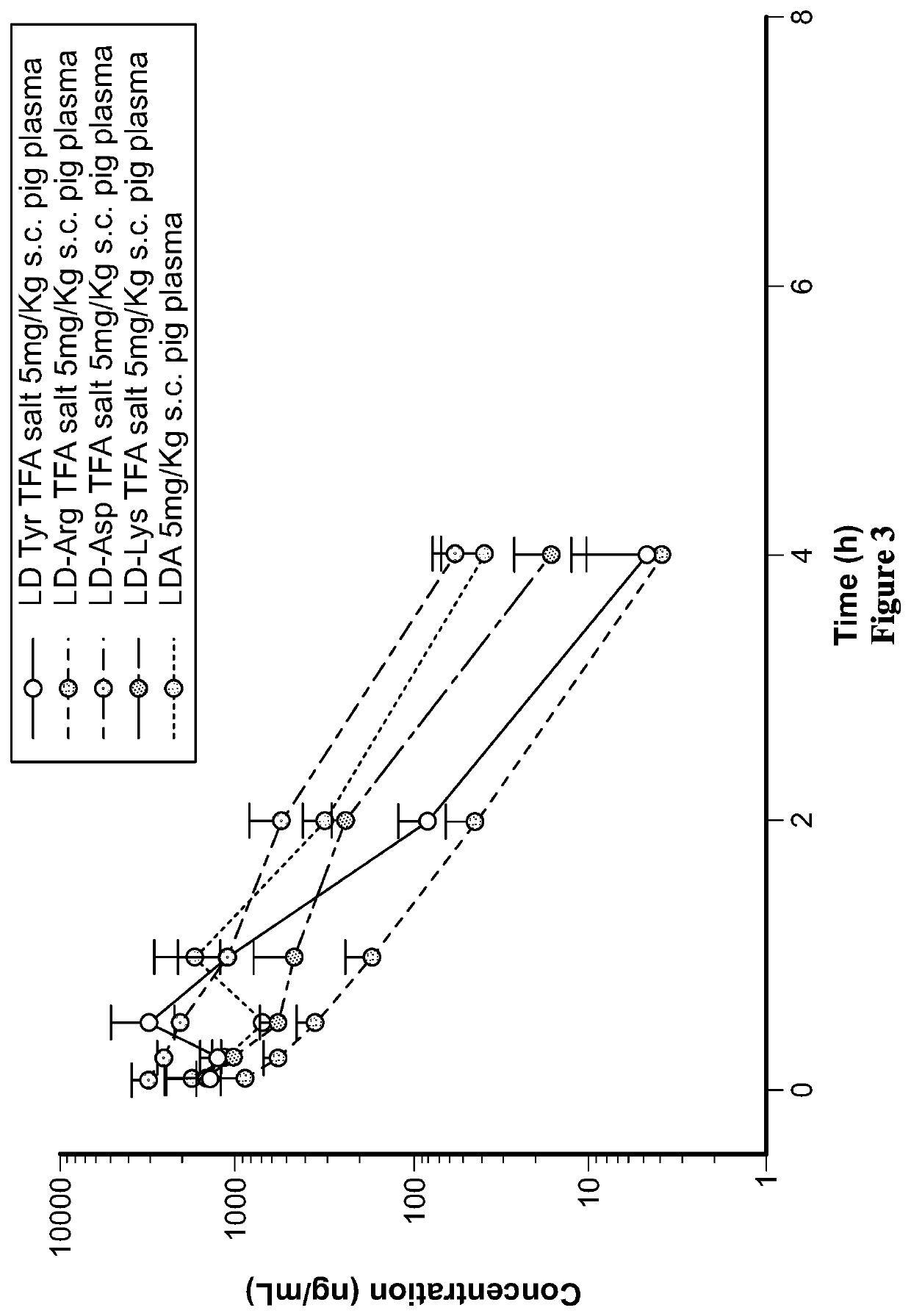Liquid compositions comprising a levodopa amino acid conjugate and uses thereof
a technology of levodopa and conjugates, applied in the field of levodopa amino acids (ldaas), can solve the problems of insufficient levodopa treatment for parkinson's disease, inability to achieve therapeutic effects, and inability to achieve previously effective doses. to achieve the effect of recurrence, and reducing the risk of recurren
- Summary
- Abstract
- Description
- Claims
- Application Information
AI Technical Summary
Benefits of technology
Problems solved by technology
Method used
Image
Examples
example 1
on of Levodopa Amino Acids (LDAA)
[0267]Ten LDAA conjugates were prepared for initial screening as trifluoroacetic acid (TFA) salts.
Preparation of Levodopa Arginine TFA Salt (LD-Arg TFA Salt)
[0268]
Preparation of Levodopa Glycine TFA Salt (LD-Gly TFA Salt)
[0269]
Preparation of Levodopa Lysine TFA Salt (LD-Lys TFA Salt)
[0270]
Preparation of Levodopa Aspartic Acid (LD-Asp)
[0271]
Preparation of Levodopa Glutamic Acid TFA Salt (LD-Glu TFA Salt)
[0272]
Preparation of Levodopa Glutamine TFA Salt (LD-Gln TFA Salt)
[0273]
Preparation of Levodopa Asparagine TFA Salt (LD-Asn TFA Salt)
[0274]
Preparation of Levodopa Tyrosine TFA Salt (LD-Tyr TFA Salt)
[0275]
Preparation of Levodopa Tryptophan (LD-Trp)
[0276]
Preparation of Levodopa-Lanthionine TFA Salt (LD-LA TFA Salt)
Step 1: Halogenation
[0277]
Step 2: Hydrolysis
[0278]
Step 3: Deprotection
[0279]
Step 4: Coupling
[0280]
Step 5: Coupling with Protected Levodopa
Step 6: Deprotection (Fmoc Removal) and Diastereomers Separation
[0281]
Step 7a: Deprotection of LD and Isol...
example 2
on of Levodopa Amino Acids (LDAA) Free Base Forms
CBz Protection of L-DOPA
[0285]The synthesis was performed using CBz-chloride and NaOH as the base. L-DOPA (200 g, 1.014 moL) was suspended in water (600 mL) and cooled to 0° C. under nitrogen. A mixture of NaOH (81.3 g, 2.033 mol) in water (600 mL) was added at 0° C. CBz-chloride (211.4 g, 1.239 mol) in dioxane (800 mL) was added at 0° C. over the course of 1 h. The mixture was allowed to warm to room temperature. After approximately 1 hour, a conversion of 73% was observed. Another portion of NaOH (4.9 g, 0.123 mol) in water (60 mL) and CBz-chloride (20.8 g, 0.122 mol) in dioxane (80 mL) was added. The reaction mixture was stirred overnight at room temperature. A conversion of 83% was observed. Another portion of NaOH (8.1 g, 0.203 mol) in water (50 mL) and CBz-chloride (35 g, 0.205 mol) in dioxane (50 mL) was added. When a conversion of 94% was obtained (1.5 h after addition) the pH was adjusted to 10 with 3 M NaOH, and the mixture ...
example 3
of LD-Lys HCl, LD-Tyr HCl and LD-Arg HCl Salts
PUM
 Login to View More
Login to View More Abstract
Description
Claims
Application Information
 Login to View More
Login to View More - R&D
- Intellectual Property
- Life Sciences
- Materials
- Tech Scout
- Unparalleled Data Quality
- Higher Quality Content
- 60% Fewer Hallucinations
Browse by: Latest US Patents, China's latest patents, Technical Efficacy Thesaurus, Application Domain, Technology Topic, Popular Technical Reports.
© 2025 PatSnap. All rights reserved.Legal|Privacy policy|Modern Slavery Act Transparency Statement|Sitemap|About US| Contact US: help@patsnap.com



